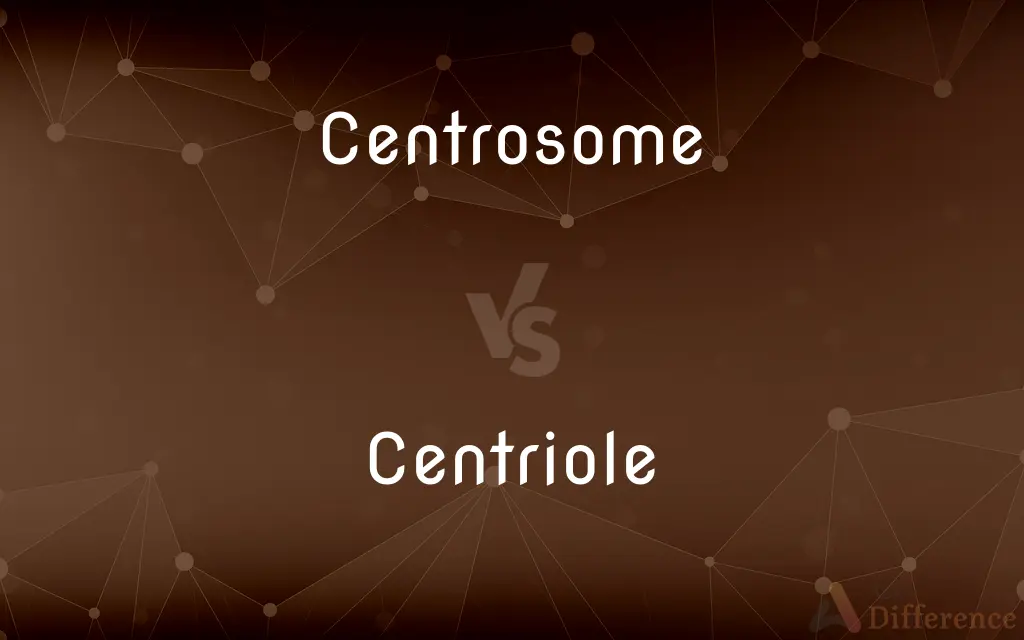Centrosome vs. Centriole — What's the Difference?
By Tayyaba Rehman — Updated on October 31, 2023
Centrosome is an organelle that organizes microtubules; centrioles are its cylindrical structures.

Difference Between Centrosome and Centriole
Table of Contents
ADVERTISEMENT
Key Differences
Centrosomes serve as microtubule organizing centers in animal cells. Centrioles are cylindrical structures within centrosomes, essential for cell division.
Each centrosome contains a pair of centrioles, oriented at right angles to each other. Centrioles are composed of nine sets of triplet microtubules arranged in a cylinder.
Centrosomes play a critical role in organizing the mitotic spindle during cell division. In Centriole during cell division, centrioles help in forming spindle fibers that segregate chromosomes.
In non-dividing cells, centrosomes organize the microtubule network. Centriole is apart from cell division, centrioles are also involved in the formation of cilia and flagella.
Centrosomes are found only in animal cells, not in plant cells. Centrioles are not found in higher plant cells but are present in most animal cells.
ADVERTISEMENT
Comparison Chart
Definition
Organelle organizing microtubules.
Cylindrical structures within centrosomes.
Composition
Contains two centrioles and pericentriolar material.
Nine sets of triplet microtubules.
Function
Organizes the mitotic spindle, microtubule network.
Involved in cell division, formation of cilia and flagella.
Presence in Cells
Found only in animal cells.
Absent in higher plants, present in most animals.
Relationship
Encompasses centrioles.
Part of the centrosome.
Compare with Definitions
Centrosome
Microtubule Organizer:
The centrosome organizes the cell's microtubules.
Centriole
Microtubule Structure:
Centrioles consist of microtubule triplets.
Centrosome
Spindle Formation:
Centrosomes are crucial in forming the mitotic spindle.
Centriole
Spindle Fiber Formation:
During mitosis, centrioles help in spindle fiber formation.
Centrosome
Animal Cell Component:
The centrosome is a distinct feature of animal cells.
Centriole
Cilia and Flagella Initiator:
Centrioles are involved in forming cilia and flagella.
Centrosome
Cell Division Regulator:
During mitosis, the centrosome plays a key role.
Centriole
Orthogonal Pair:
Two centrioles lie at right angles to each other within a centrosome.
Centrosome
Dual Centriole Holder:
Each centrosome contains two centrioles.
Centriole
Cell Division Participant:
Centrioles are vital for proper cell division.
Centrosome
In cell biology, the centrosome (Latin centrum 'center' + Greek sōma 'body') (also called cytocenter) is an organelle that serves as the main microtubule organizing center (MTOC) of the animal cell, as well as a regulator of cell-cycle progression. The centrosome provides structure for the cell.
Centriole
In cell biology a centriole is a cylindrical organelle composed mainly of a protein called tubulin. Centrioles are found in most eukaryotic cells, but are not present in conifers (Pinophyta), flowering plants (angiosperms) and most fungi, and are only present in the male gametes of charophytes, bryophytes, seedless vascular plants, cycads, and Ginkgo.
Centrosome
A small region of cytoplasm adjacent to the nucleus that contains the centrioles and serves to organize microtubules.
Centriole
One of two cylindrical cellular structures that are composed of nine triplet microtubules and form the asters during mitosis.
Centrosome
(cytology) An organelle, near the nucleus in the cytoplasm of most organisms, that controls the organization of its microtubules
Centriole
(biology) A barrel-shaped microtubule structure found in most animal cells, important in the process of mitosis (nuclear division).
Centrosome
A peculiar rounded body lying near the nucleus of a cell. It is regarded as the dynamic element by means of which the machinery of cell division is organized.
Centriole
One of two small cylindrical cell organelles composes of nine triplet microtubules, which form the asters during mitosis.
Centrosome
Small region of cytoplasm adjacent to the nucleus; contains the centrioles and serves to organize the microtubules
Centriole
One of two small cylindrical cell organelles composes of 9 triplet microtubules; form the asters during mitosis
Common Curiosities
What is the primary function of the centrosome?
The centrosome organizes microtubules and assists in cell division.
What are centrioles made of?
Centrioles are made of nine sets of microtubule triplets.
Can cells function without a centrosome?
Some cells can function without a centrosome, but it is vital for mitosis in most animal cells.
What is the role of centrioles in cilia formation?
Centrioles form the basal bodies that give rise to cilia and flagella.
How many centrioles are in a centrosome?
There are two centrioles in each centrosome.
Are centrioles present in all animal cells?
Centrioles are present in most animal cells but absent in higher plants.
Can centrioles function independently of the centrosome?
Centrioles can function in cilia and flagella formation independently of the centrosome.
How do centrosomes contribute to cellular organization?
Centrosomes organize the cell's microtubule network, contributing to cellular shape and transport.
Are centrioles essential for all types of cell division?
Centrioles are not essential for all types of cell division, as some cells can divide without them.
What is the significance of centrosomes in cancer cells?
Abnormalities in centrosomes are often associated with cancer, leading to abnormal cell division.
Can centrioles replicate independently?
Centrioles can replicate independently of DNA replication but usually do so during the S phase.
Do plant cells have centrosomes?
Plant cells lack centrosomes but have other microtubule organizing centers.
What happens to centrioles during cell division?
During cell division, centrioles migrate to opposite poles and help in spindle formation.
What is the relationship between the centrosome and centriole?
The centrosome contains and organizes the centrioles.
What happens to the centrosome during interphase?
During interphase, the centrosome duplicates in preparation for cell division.
Share Your Discovery

Previous Comparison
Successfully vs. Successful
Next Comparison
Cardboard vs. CardAuthor Spotlight
Written by
Tayyaba RehmanTayyaba Rehman is a distinguished writer, currently serving as a primary contributor to askdifference.com. As a researcher in semantics and etymology, Tayyaba's passion for the complexity of languages and their distinctions has found a perfect home on the platform. Tayyaba delves into the intricacies of language, distinguishing between commonly confused words and phrases, thereby providing clarity for readers worldwide.












































